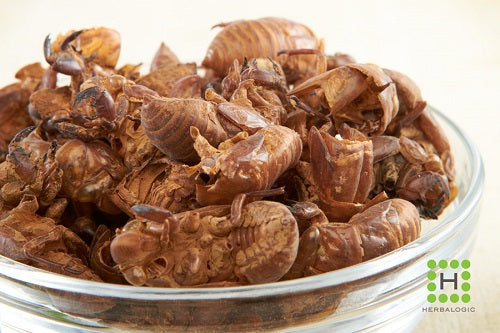Cicada Molting at a Glance

The cicada has a history as a symbol of immortality in China, with examples decorating bronze vessels dating as far back as 1500 B.C.E. Carved-jade cicadas were sometimes placed in the mouths of the dead, not unlike the use of scarab beetles in ancient Egypt.
In modern herbal medicine, the insect itself is not the key ingredient. Rather, herbalists use the cast off, mineralized exoskeleton left behind when the nymph emerges from the ground, climbs the nearest suitable vertical surface, and breaks out into wingy adulthood. The chitinous armor remains clinging to tree trunks and branches, and the adults take to the canopies and get loud with the monotonous, pulsing chatter that has become synonymous with summer.
Classification
Scientific Name
Cryptotympana atrata or Cryptotympana pustulata
Common Name (Western)
Cicada Molting
Chinese Name (Pin Yin)
Chan Tui
Preparation Name
Periostracum cicadae
Description
Some 2,500 species of cicadas can be found on every continent but Antartica. All are part of the Cicadoidea superfamily of insects characterized by prominent (though not especially large) eyes set wide apart and well-developed, translucent wings with prominent veins.
The species used in Chinese medicine typically come from China, Taiwan, or Japan. The exoskeleton of the nymph cicada, which is shed naturally when it morphs into adulthood, is the part used in traditional medicine and is primary composed of chitin.
The name "cicada" comes directly from the Latin cicada, meaning "tree cricket."
Uses
Cicada molting is essentially chitin. In its unprocessed form, chitin is translucent, pliable, resilient, and quite tough. The material is frequently used in surgical sutures, as it biodegrades over time. It also has been shown to speed the healing of wounds when cotton bandages are coated with it.
In traditional Chinese medicine, cicada molting is used in herbal formulas to "dispel wind-heat." For the uninitiated, this translates into uses for sore or swollen throat, itchy eyes and skin, and blurry vision.
Cautions
Cicada molting is essentially chitin, and chitin is essentially cellulose, the most abundant organic polymer on earth. It's what makes up most of a plant's cell wall structure and is considered safe to ingest. In many cultures, cicadas are an important food and are consumed with no ill effects.
-
- As mentioned in our General Precautions, do not use if pregnant or nursing
- Avoid use if you have rashes or other skin issues until you can consult a healthcare professional.

Uses in Herbalogic Easy Breather
Cicada molting is used in only one Herbalogic formula, the ever-popular Easy Breather, in combination with other herbs for allergy and sinus support.
Easy Breather is our version of a classic formula created to strengthen the immune system prior to seasonal changes, travel, and stress. It also helps the body resist the effects of environmental irritants, especially pollen, dust, smoke, mold, and pollution. The cicada shell is an important ingredient in Easy Breather, in particular for it's natural antihistamine properties, for helping itchy eyes, ears and nose.



1 comment
Each year I collect cicada molts for my own use. Then I just take Easy Breather instead. So I have jars of molts from each year stored in the basement and the current collection on the kitchen table while the Easy Breather is on the kitchen counter, ready to use.